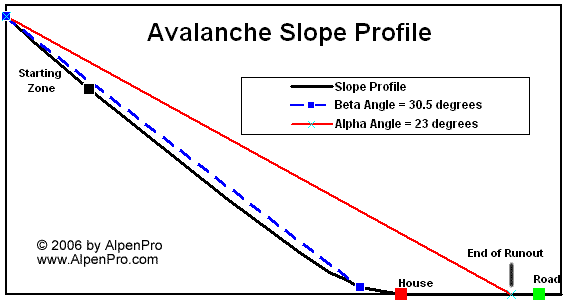[Click here to return to the page you came from!]
Alpha Angle, Beta Angle
Also: Angle of Reach, Runout Angle
The alpha angle is the angle between the horizontal and a line drawn from the highest point of the crown face to the toe of the debris. The alpha angle can be measured for an individual avalanche, but it is more commonly (and usefully) calculated for a specific return period. Extreme values for an alpha angle (such as that for a 100 year or 300 year avalanche) can be determined from historical records, tree ring data, or statistical methods. The alpha angle is also termed the angle of reach or the runout angle. For 100 year avalanches this angle typically ranges from about 18 to 22 degrees
The beta angle is the angle measured to the top of the starting zone from the place where the slope first becomes 10 degrees (locally). This is a terrain feature of the particular path and is not different for different events, as the alpha angle is. An extreme event alpha angle (such as that of a 100-year avalanche) can be estimated from a beta angle using statistical methods, but the parameters vary from one mountain range to another (independent of prevailing climate).
The graph below is an actual profile showing the alpha and beta angles and is from an avalanche engineering project by AlpenPro.

This glossary is a work in progress and is made possible by AlpenPro.



